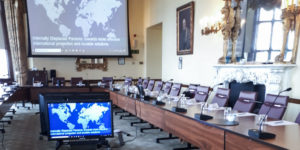In the beautiful setting of Wiston House with its remarkable history resounding in every room, I was pleased to be able to attend a recent Wilton Park conference on “Internally Displaced Persons: towards more effective international protection and durable solutions (WP1705)”. Gathering (some of) “the great and the good” of practitioners working on IDP situations, the meeting provided an opportunity to take a step back, collectively reflect on both progress and roadblocks, and provide some pointers that will hopefully be picked up by members of the upcoming High-Level Panel on Internal Displacement.
With momentum building around this initiative, the High-Level Panel is expected to be formed in 2020 and last for a duration of 12 months. Expectations are already running high and its precise scope (and membership) is still to be defined, so the timing of this meeting could not have been better. Beyond the session on “social and economic impacts: balancing out the costs and benefits” (that I was invited to contribute to), from my perspective, three things in particular stood out from the discussions as a whole:
Regarding implications for profiling and generating ideas to enhance the value and impact of the contribution that can be made by JIPS, each of these points have a specific significance.

The Wilton Park conference room all set for the discussion to start. Julia Purcell / Wilton Park © 2019
As indicated by their name – internally displaced persons – IDPs are internal to the countries in which they reside. This clearly distinguishes IDPs from refugees and other international migrants. Discussions at Wilton Park highlighted how critical it is for this simple fact to be the starting point for response and, unfortunately, how often it is forgotten in practice. In addition to what this means for their rights, for their justifiable demands from states, this is also linked to understanding why problems occur when a different “identity” or “status” is created or allocated to them.
From a data perspective it enhances the need to focus efforts on vulnerability analysis in the broader sense and to avoid the establishment of systems that in practice create a specific status for IDPs in addition to their status as (potentially vulnerable) citizens.
It supports arguments for investing in strategies of inclusion – inclusion in data systems as well as in support services and other sectors – and in that way underlines the importance of the ongoing work of the Expert Group on Refugee and IDP Statistics (EGRIS) that is developing International Recommendations on IDP Statistics to do just that.
Inclusion, of course, also means inclusion in development planning processes – integrating displacement specific issues into national and local development plans. This requires data and analysis to be structured, aligned and well-timed to facilitate this, as various participants from Wilton Park highlighted citing the good example of Somalia where the 2016 profiling results fed directly into the national development plan.

Wiston House, a Elizabethan manor house in the South Downs National Park, UK – Wilton Park © 2019
That our efforts to reduce and resolve internal displacement should focus beyond the individuals directly affected – the IDPs – and consider the broader displacement situation as a whole, was also a recurring theme of the conversation at Wilton Park. This is something that has for a long time been a central part of the work we do at JIPS and how we encourage our partners to shape the scope of their profiling exercises.
Although this point was raised from various perspectives – avoiding social tensions that can arise from treating IDPs differently from others living in similar areas or under similar conditions, the complexities of urban contexts demanding a more comprehensive approach, or the logic of development programming itself adopting a poverty lens that is mostly oblivious to status – time and again, this important point rang through the room: efforts, including those of the High-Level Panel, should focus on displacement situations as a whole.
From a data perspective this also rings true. Whilst data on IDPs in isolation has its use, in the long run it can become problematic and lead to significant gaps in understanding, which themselves become reflected in policy and programming efforts.
Therefore, it is far better to invest more strategically and systematically in data and analysis that facilitates a comparison between displaced persons and other population groups as much as possible, be they local/host populations, refugees, economic migrants or returnees.
As a community we are of course a long way off from doing this systematically, but there are many good examples that can be shared (such as the profiling exercises in Sudan and the Kurdistan Region of Iraq that JIPS supported in recent years).
“Displacement situations” of course do not only refer to people or groups but also to environmental factors such as the availability, capacity or quality of services in areas affected by displacement, or the broader policy, security or governance environment of the city/region/country in question. Incorporating these factors into profiling methodologies has been an important aspect of our work in urban areas (see e.g. the UrBAN-Syria project) but something that we already know we need to get better at.
Moving away from language imposed by institutions that never perfectly fits the reality on the ground, coordination structures that are designed to improve humanitarian response but aren’t always inclusive of the diversity of relevant actors, and funding mechanisms that do not always facilitate adequate responses to internal displacement, the Wilton Park gathering also articulated the importance of ensuring a central role for both affected states and affected communities in global discussions to advance collective practice in this area. Without this, solutions will not be grounded in reality and will not be effective.
Ideas were shared around participation in the High-Level Panel of representatives from affected states at both national and local levels, and on strategies for including the voices of affected communities within the scope of its work. Ensuring that data, research and analysis that underpin our responses to internal displacement include these perspectives is also vital. It is something that, from JIPS’ experience, requires careful coordination and oversight of data collection and joint analysis processes on the one hand (as was done in Greece), but also innovative practices for community engagement even in the more technical steps of the work.
As I expressed during my main intervention, designing and implementing workable proposals for solutions and ensuring key stakeholders are on board requires, as a starting point, a reliable and more or less agreed-upon evidence-base.

A joint effort by JIPS and the Feinstein International Center, the publication points to eight key areas that are in need of revision when it comes to profiling of IDP situations.
This requires critical reflection about what is already “known” about displacement, genuine collaboration that necessarily includes compromise, an environment that encourages strategic use of reliable data, and a whole lot of patience because shifting policy on displacement cannot be achieved overnight. Unfortunately, current practice does not demonstrate these qualities in abundance, nevertheless we can build on a number of good practices to push the way forward (and this is something we’ve also discussed in Go Figure).
Whilst we wait patiently for the High-Level Panel to start work (and even more eagerly for its recommendations to come out the other end), discussions at Wilton Park made one thing crystal clear. The issue of more effective protection and solutions for IDPs is complicated and many attempts – commitments, resolutions, frameworks – have been made in the past to address it. The High-Level Panel is not starting from scratch, and to make a difference it needs to be weary of this and to ensure it has clear objectives and scope, and is well positioned to ensure its outputs will be followed up on.
From a JIPS perspective, we look forward to supporting its efforts in any way we can and, in the meantime, continue to engage in these discussions that already bring much added value to our work. Both in assuring us of the relevance of what we do, but also to help guide our future priorities and investments.